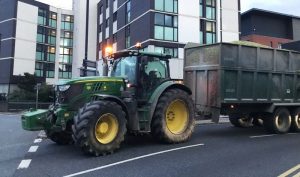
Flashing amber beacons are usually used to indicate slow-moving vehicles. Often slow-moving vehicles are larger or wider than usual vehicles and may be involved in road maintenance work. As such, when you see amber flashing lights you should check your mirrors, adjust your speed, and consider adjusting your road position. If you are being approached by a vehicle with flashing amber lights try not to panic. Make sure you allow room for it to pass whilst complying with traffic signs and without endangering yourself or other road users.
What do the different coloured beacons warn of?
There are 3 main colours of beacon used on the roads in the UK. In each case, they are to warn you of a potential hazard that you will need to respond to. However, it is important to understand the different colours to ensure you know how you should respond:
Blue beacon
These are used for ambulances, fire engines, police, doctors or other emergency vehicles. They will flash and may be used alongside flashing headlights and the sound of sirens. You should allow them to pass as easily and safely as possible.
Green beacon
Green beacons indicate that a doctor or registered medical practitioner is on their way to or from an emergency situation. You should allow them to pass as easily and safely as possible.
Amber beacon
Amber beacons usually indicate slow-moving vehicles that may be larger or wider than usual. You will need to be prepared to adjust your speed and potentially your road position. Amber lights can be found on any of the following vehicles:
- Apparatus in, on, over, or under the road
- Breakdown recovery vehicles
- Fuel testing vehicles
- Refuse vehicles
- Removal vehicles
- Road clearance/maintenance vehicles
- Surveying vehicles
- Vehicles with a maximum speed of under 25mph
- Vehicles more than 2.9m wide
Theory Test Question
Have you answered the question: What does a flashing amber beacon mean when it’s on a moving vehicle? Let’s look at each answer in turn and check your understanding.
The vehicle is a doctor’s car
Wrong! Green coloured beacons are found on doctors’ cars (or any medical practitioner registered with the General Medical Council).
The vehicle is slow-moving
Correct! Amber beacons are generally used to indicate slow-moving vehicles. They may also indicate that the vehicle is large. You will also often see amber lights when road maintenance is in progress. As such, when you see an amber light you should adjust your speed and road position accordingly.
The vehicle belongs to a school crossing patrol
Wrong! School crossing patrols are pedestrianised and overseen by people commonly referred to as ‘lollipop people’.
The vehicle has broken down
Wrong! Amber lights may be found on a breakdown recovery vehicle but are not used to indicate the vehicle using the amber lights has broken down themselves.
References
In section 7 of the official DVSA guide to driving, it states:
There are several types of slow-moving vehicle that you may encounter on the roads. These include farm machinery, tractors, roadworks vehicles and refuse collection vehicles. Most will have flashing amber beacons.Tractors and farm machinery will often pull in to the left when it’s safe, or if there’s space to do so, to let a queue of traffic pass. However, they’re not always able to do so.
Travelling behind a slow-moving vehicle can be frustrating, but be patient. Wait until the road ahead is completely clear of oncoming traffic and you’re sure it’s both safe and legal to overtake. Remember also that there may be workers in the road – for example, around roadworks vehicles or refuse collection trucks.
It also states in section 12:
Rule 225 in the Highway Code states:















